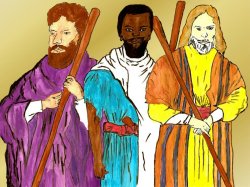How did this pagan custom go into the church?
 Then how did this pagan custom creep into the Western Christian world?
Then how did this pagan custom creep into the Western Christian world?
The New Schaff-Herzog Encyclopaedia of Religious Knowledge explains it clearly, in its article on “Christmas”: “How much the date of the festival depended upon the pagan Brumalia (Dec. 25) following the Saturnalia (Dec. 17-24), and celebrating the shortest day of the year and the ‘new sun’…cannot be accurately determined.
The pagan Saturnalia and Brumalia WERE TOO DEEPLY ENTRENCHED IN POPULAR CUSTOM TO BE SET ASIDE BY CHRISTIAN INFLUENCE…
The pagan festival with its riot and merrymaking was so popular that Christians were glad of an excuse to continue its celebration with little change in spirit and manner.
Christian preachers of the West and the Near East protested against the unseemly frivolity with which Christ’s birthday was celebrated, while Christians of Mesopotamia ACCUSED THEIR WESTERN BRETHREN OF IDOLATRY AND SUN WORSHIP FOR ADOPTING AS CHRISTIAN THIS PAGAN FESTIVAL.”
Remember, the Roman world had been pagan. Prior to the fourth century, Christians were few in number, though increasing, and were persecuted by the government and by pagans.
But, with the advent of Constantine as emperor, who made his profession of Christianity in the fourth century, placing Christianity on an equal footing with paganism, people of the Roman world began to accept this now-popular Christianity by the hundreds of thousands.
But remember, these people had grown up in pagan customs, chief of which was this idolatrous festival of December 25th.
It was a festival of merrymaking, with its special spirit. They enjoyed it!
They didn’t want to give it up. Now this same article in the New Schaff-Herzog Encyclopedia of Religious Knowledge explains how the recognition by Constantine of Sunday,
which had been the day of pagan sun worship, and how the influence of the pagan Manichaeism, which identified the SON OF GOD with the physical SUN, gave these pagans of the fourth century, now turning over wholesale to “Christianity,”
their excuse for calling their pagan-festival date of December 25th (birthday of the SUN-god), the birthday of the SON OF GOD.
And THAT is how “Christmas” became fastened on our Western world. We may call it by another name, but it’s the same old pagan sun-worshipping festival still. The only change is in what we call it.
You can CALL a rabbit a “lion,” but it’s still a rabbit, just the same.
Again from the Encyclopaedia Britannica: “Certain Latins, as early as 354, may have transferred the birthday from January 6th to December 25, WHICH WAS THEN A MITHRAIC FEAST…OR BIRTHDAY OF THE UNCONQUERED SUN…
The Syrians and Armenians, who clung to January 6th, accused the Romans of sun worship and idolatry, contending…that the feast of December 25, had been invented by disciples of Cerinthus…”
Fortsättn: The real origin of christmas,
By Herbert Armstrong



